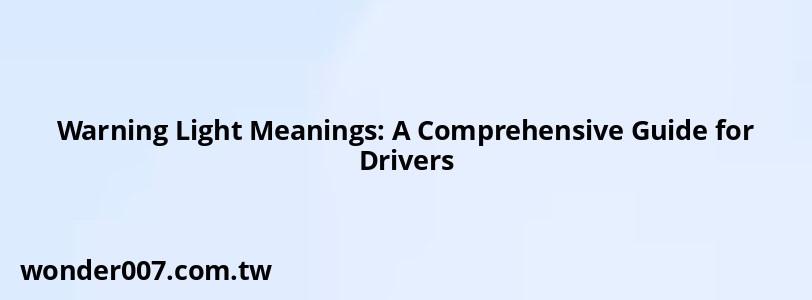Warning Light Meanings: A Comprehensive Guide for Drivers

Understanding the warning lights in your car is essential for maintaining vehicle safety and performance. These lights serve as your vehicle's way of communicating potential issues, and recognizing their meanings can prevent minor problems from escalating into serious repairs.
Types of Warning Lights
Dashboard warning lights are typically categorized by color, which indicates the urgency of the issue:
- Red Lights: Indicate a serious problem that requires immediate attention. Examples include the brake warning light and oil pressure warning light.
- Amber/Yellow Lights: Suggest that something is not functioning properly but does not require immediate action. For instance, the tire pressure warning light falls into this category.
- Green/Blue Lights: Informational lights that indicate systems are functioning correctly, such as turn signals or high beam indicators.
Common Warning Lights and Their Meanings
Here are some of the most common dashboard warning lights you may encounter:
| Warning Light | Meaning |
|---|---|
| Check Engine Light | Indicates a problem with the engine or emissions system. Should be checked by a mechanic soon. |
| Oil Pressure Light | Signals low oil pressure; stop the engine immediately to avoid damage. |
| Tire Pressure Warning Light | Indicates one or more tires are under-inflated; check tire pressures. |
| Brake Warning Light | Could mean the parking brake is engaged or there’s an issue with the braking system. |
| Battery Warning Light | Indicates a problem with the vehicle's charging system; check battery and alternator. |
| Airbag Warning Light | Signals a fault in the airbag system; should be addressed immediately for safety. |
What to Do When a Warning Light Illuminates
When you see a warning light on your dashboard, follow these steps:
1. Assess the Color: Determine if it's red, yellow, or green to understand the urgency.
2. Refer to Your Owner's Manual: Each vehicle may have different symbols; consult your manual for specific meanings.
3. Take Action: For red lights, pull over safely and turn off the engine. For yellow lights, schedule a service appointment soon.
4. Monitor Performance: If any unusual sounds or behaviors accompany a warning light, take immediate action.
FAQs About Car Warning Lights
FAQs About Warning Lights
- What does it mean if multiple warning lights come on?
This could indicate a more significant issue; consult a mechanic immediately. - Can I drive my car with the check engine light on?
You can drive for a short time, but it’s advisable to get it checked as soon as possible to avoid further damage. - What should I do if my brake warning light comes on?
If this light is illuminated, check if the parking brake is engaged. If not, stop driving and have your brakes inspected.
Understanding your car's dashboard warning lights is crucial for safe driving and vehicle maintenance. By being aware of what these symbols mean and how to respond, you can ensure your vehicle remains in good working condition and avoid costly repairs down the road.
Related Posts
-
How to Program 2002 Chevy Cavalier Key Fob: Step-by-Step Guide
28-01-2025 • 173 views -
2003 Infiniti Q45: Fuse Box Location and Guide
28-01-2025 • 131 views -
2004 Buick LeSabre Center Console Lid: Repair and Replacement Guide
30-01-2025 • 184 views -
Master Warning Light: Understanding Your Nissan's Dashboard Alerts
26-01-2025 • 283 views -
Crankshaft Position Sensor: Essential Guide for 2011 Hyundai Accent
29-01-2025 • 240 views
Latest Posts
-
How To Turn Off Paddle Shifters Mercedes
01-02-2025 • 377 views -
2015 Chevy Traverse AC Recharge Port Location
01-02-2025 • 409 views -
Are O2 Sensors Covered Under Warranty
01-02-2025 • 376 views -
Power Steering Fluid Leak On Passenger Side
01-02-2025 • 457 views -
Rear Brake Caliper Piston Won't Compress
01-02-2025 • 356 views
Popular Posts
-
Power Steering and ABS Light On: Causes and Solutions
27-01-2025 • 643 views -
EPC Light: Understanding Causes and Solutions
26-01-2025 • 1053 views -
EPC Warning Light: What It Means for Your Vehicle
27-01-2025 • 630 views -
Hino Warning Lights: Understanding Dashboard Alerts
26-01-2025 • 765 views -
V12 Engine Costs: What You Need to Know
26-01-2025 • 679 views
